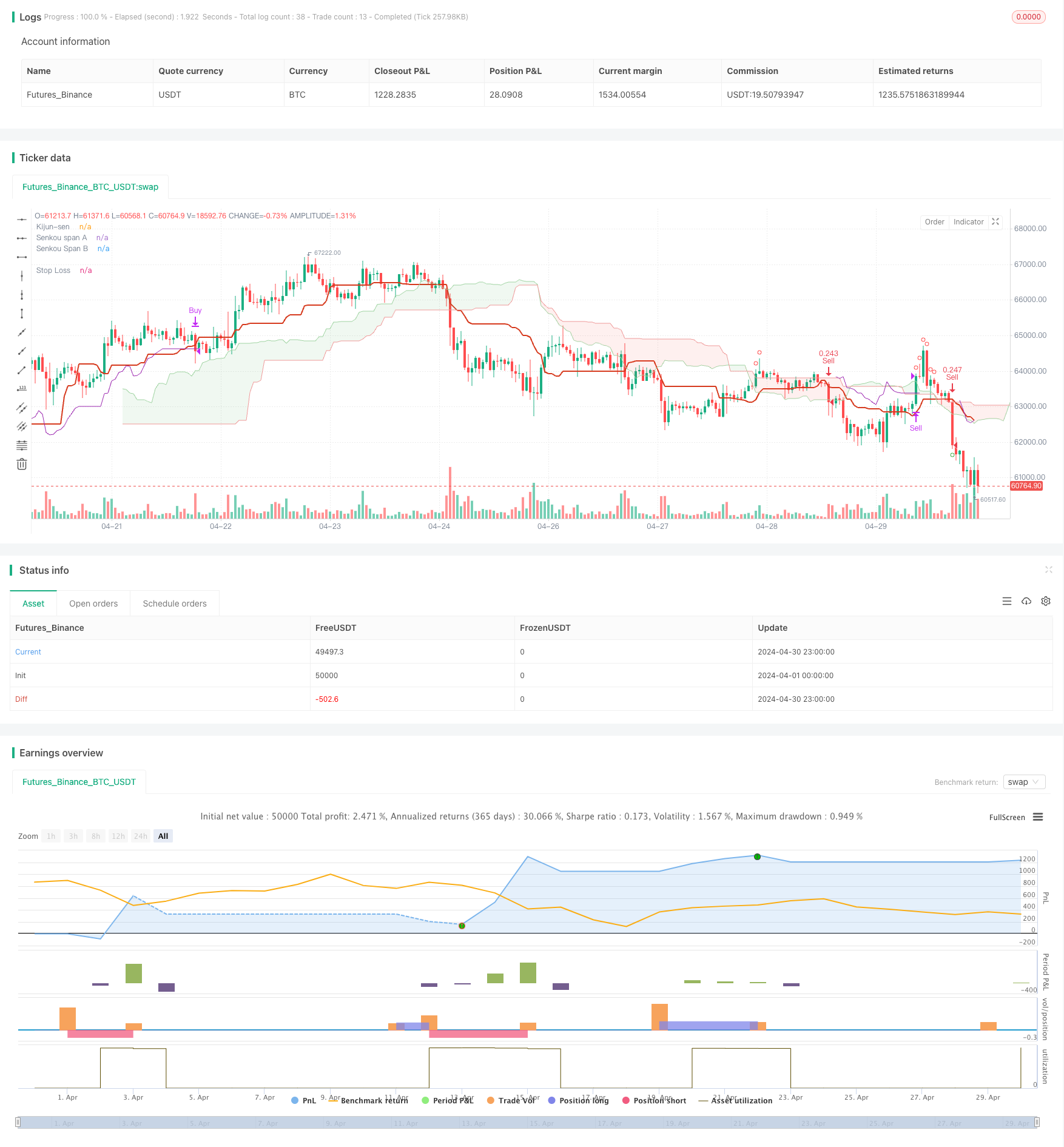
概述
该策略利用Ichimoku Kumo指标来判断市场趋势和交易信号。策略在Kumo云之下做多,在Kumo云之上做空。策略使用ATR指标作为止损,同时使用Kijun-sen线和Senkou Span线的突破作为入场信号的确认。该策略试图捕捉强势趋势中的交易机会,同时控制风险。
策略原理
- 使用Ichimoku指标中的Kijun-sen、Tenkan-sen和Senkou Span线来判断市场趋势。
- 当收盘价低于Senkou Span线且Kijun-sen线在Kumo云上方时,产生做多信号。
- 当收盘价高于Senkou Span线且Kijun-sen线在Kumo云下方时,产生做空信号。
- 使用ATR指标计算止损位置,止损位置为最近5根K线的最高/低点减/加3倍ATR。
- 当价格突破止损位置时,平仓离场。
策略优势
- 该策略基于Ichimoku指标,能够全面分析市场趋势。
- 策略同时考虑价格与Kijun-sen线和Senkou Span线的关系,提高入场信号的可靠性。
- 使用ATR作为止损,能够动态调整止损位置,更好地控制风险。
- 止损位置的设置考虑了市场波动性,能够适应不同的市场状况。
策略风险
- 该策略在震荡市中可能会产生较多的虚假信号,导致频繁交易和资金损失。
- 策略的表现依赖于Ichimoku指标参数的选择,不同参数可能产生不同的交易结果。
- 在剧烈行情中,价格可能会快速突破止损位置,导致较大的滑点和损失。
策略优化方向
- 引入其他技术指标或量价分析,以辅助判断趋势和入场时机,提高信号的准确性。
- 优化止损位置的设置,如考虑使用跟踪止损或移动止损,以更好地保护账户安全。
- 在策略中加入仓位管理,根据市场波动性和账户风险调整每笔交易的仓位大小。
- 对策略进行参数优化,找到最适合当前市场状况的参数组合。
总结
该策略利用Ichimoku指标的多个组成部分,实现了对市场趋势的全面分析。同时,策略使用ATR止损来控制风险,增强了策略的稳健性。然而,该策略在震荡市中可能表现欠佳,并且依赖于参数选择。未来可以通过引入其他分析方法、优化止损和仓位管理等方式,进一步提升策略的表现。
策略源码
/*backtest
start: 2024-04-01 00:00:00
end: 2024-04-30 23:59:59
period: 1h
basePeriod: 15m
exchanges: [{"eid":"Futures_Binance","currency":"BTC_USDT"}]
*/
// This Pine Script™ code is subject to the terms of the Mozilla Public License 2.0 at https://mozilla.org/MPL/2.0/
// © muratatilay
//@version=5
strategy(
"Kumo Trade Concept",
overlay=true,
initial_capital=10000,
currency=currency.USDT,
default_qty_type=strategy.percent_of_equity,
default_qty_value=30,
commission_type=strategy.commission.percent,
commission_value=0.1,
margin_long=10,
margin_short=10)
// ICHIMOKU Lines
// INPUTS
tenkanSenPeriods = input.int(9, minval=1, title="Tenkan-sen")
kijunSenPeriods = input.int(26, minval=1, title="Kijun-sen")
senkouBPeriod = input.int(52, minval=1, title="Senkou span B")
displacement = input.int(26, minval=1, title="Chikou span")
donchian(len) => math.avg(ta.lowest(len), ta.highest(len))
tenkanSen = donchian(tenkanSenPeriods)
kijunSen = donchian(kijunSenPeriods)
senkouA = math.avg(tenkanSen, kijunSen)
senkouB = donchian(senkouBPeriod)
// Other Indicators
float atrValue = ta.atr(5)
// Calculate Senkou Span A 25 bars back
senkouA_current = math.avg(tenkanSen[25], kijunSen[25])
// Calculate Senkou Span B 25 bars back
senkouB_current = math.avg(ta.highest(senkouBPeriod)[25], ta.lowest(senkouBPeriod)[25])
// Kumo top bottom
senkou_max = (senkouA_current >= senkouB_current) ? senkouA_current : senkouB_current
senkou_min = (senkouB_current >= senkouA_current) ? senkouA_current : senkouB_current
// Trade Setups
long_setup = (kijunSen > senkou_max) and (close < senkou_min)
short_setup = (kijunSen < senkou_min ) and ( close > senkou_max )
// Check long_setup for the last 10 bars
long_setup_last_10 = false
for i = 0 to 50
if long_setup[i]
long_setup_last_10 := true
short_setup_last_10 = false
for i = 0 to 50
if short_setup[i]
short_setup_last_10 := true
closeSenkouCross = (close > senkou_max) and barstate.isconfirmed
closeKijunCross = (close > kijunSen )
senkouCloseCross = close < senkou_min
kijunCloseCross = close < kijunSen
// Handle Trades
// Enter Trade
var float trailStopLong = na
var float trailStopShort = na
if ( closeSenkouCross and long_setup_last_10 and closeKijunCross )
strategy.entry(id="Buy", direction = strategy.long)
trailStopLong := na
if senkouCloseCross and short_setup_last_10 and kijunCloseCross
strategy.entry(id="Sell", direction = strategy.short)
trailStopShort := na
// Update trailing stop
float temp_trailStop_long = ta.highest(high, 5) - (atrValue * 3)
float temp_trailStop_short = ta.lowest(low, 5) + (atrValue * 3)
if strategy.position_size > 0
if temp_trailStop_long > trailStopLong or na(trailStopLong)
trailStopLong := temp_trailStop_long
if strategy.position_size < 0
if temp_trailStop_short < trailStopShort or na(trailStopShort)
trailStopShort := temp_trailStop_short
// Handle strategy exit
if close < trailStopLong and barstate.isconfirmed
strategy.close("Buy", comment="Stop Long")
if close > trailStopShort and barstate.isconfirmed
strategy.close("Sell", comment="Stop Short")
// PRINT ON CHART
plot(kijunSen, color=color.rgb(214, 58, 30), title="Kijun-sen", linewidth=2)
p1 = plot(senkouA, offset=displacement - 1, color=#A5D6A7, title="Senkou span A")
p2 = plot(senkouB, offset=displacement - 1, color=#EF9A9A, title="Senkou Span B")
fill(p1, p2, color=senkouA > senkouB ? color.rgb(67, 160, 71, 90) : color.rgb(244, 67, 54, 90))
// PRINT SETUPS
plotshape(long_setup , style=shape.circle, color=color.green, location=location.belowbar, size=size.small)
plotshape(short_setup, style=shape.circle, color=color.red, location=location.abovebar, size=size.small)
// Trail Stop
plot(strategy.position_size[1] > 0 ? trailStopLong : na, style=plot.style_linebr, color=color.purple, title="Stop Loss")
plot(strategy.position_size[1] < 0 ? trailStopShort : na, style=plot.style_linebr, color=color.purple, title="Stop Loss")